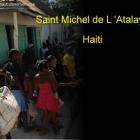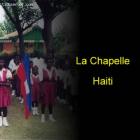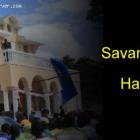ADVERTISEMENT
carnival
The 2013 Carnival Celebration Aboard Adriana Cruise Ship
National Carnival 2012 Committee announced the arrangements of a three day cruise ship. The cruise ship is expected to be in the Bay of Cayes all through the Carnival festival beginning 19th February till 22nd February. The Adriana Cruise ship M.V. is to serve as a floating hotel in the Cap-Haitian and Jacmel Carnival in 2013.
The Cruise - 18th February To 22nd February
This floating hotel, Adriana Cruise Ship, has a large number of facilities and amenities. It is expected to depart in the afternoon on 18th February, Saturday from Port-au-Prince, Haiti. All night, on board there will be a Masquerade Ball. It will arrive at Cayes on the morning of 19th February.
Carnival in Haiti has a very strong political dimension
The Carnival celebration in Haiti is a time of art, song, dance, and costume. It is a time of self expression also. During this annual celebration, residents of Haiti take to the streets with striking costumes and dance during the parades. they also use this opportunity to send messages to their leaders. Many of the Carnival songs in Haiti are about sex, community's scandals, gossip and mockery of famous people and political personalities.
Surprisingly enough, during the Carnival season, they criticize openly the political leaders
Haitian Carnival is a time or self-expression and creativity where all Haitian get together. The celebration consists of a great deal of song, dance, and costume production, but the importance of the Haitian carnival lies in its ability to let the regular people express themselves, their beliefs, and their creativity.
Carnival in Haiti - Ciray Costume
This is what I know about "Madi Gras Ciray" which is the people you always see in the carnival that you don't want them to come close to.
According to some some elderly Haitians that i had the privilege to speak to about the Haitian Carnival, I learned that the "Madi gras Ciray do have a meaning in the Haitian history going back to the colonization period.
Painting oneself in black has been a way to avoid capture and consequently heavy punishment from the Slave master. I was told that during the season that came before easter, only the "Colon or slave masters were allowed to do public celebration. The Afranchi or "Les Gens de Couleur" were to some extent allowed to participate in some limited celebration. For the Black slaves, public celebration were forbidden
Chaloska, The story of Charles Oscar and Carnival
The story of Chaloska goes as follows, Chief Charles Oscar was a military commander in charge of the police in Jacmel. He was feared by many
The specific things that made him a distinct figure is that he was tall and strong, with big teeth.
His story became one that crosses several generations in Haiti and somehow stays with the time.
It came at a time of great instability in Haiti, politically and socially. President Vilbrun Guillaume Sam was forced to contend with a revolt against his government, led by Dr. Rosalvo Bobo. Unable to do so, he fled to the French embassy, where he received asylum. The mulatto rebels broke into the embassy and captured him. The Haitian president was beating to death and his cadaver ripped into pieces and paraded the parts through the capital's neighborhoods.
Canaval telling story of Haiti - Haitian Afranchi
The term Affranchi was a French legal term classifying some slaves after obtaining their freedman or emancipation
This was a social class in the former Haiti, Saint-Domingue. The Affranchi at the time were in the social class between those who were free whites and enslaved Black people.
The Afranchi class was not only determined by your skin color at the time. Some of them werefreed people of mixed race and others were freed blacks. For instance, a mixed child born of a white father and a black mother was born free and would fall under the Afranchi class
Kanaval Des Etudients in Haiti
Carnival of students usually takes place on the last Friday before Dimanche Gras, Lundi Gras and Mardi Gras. This is jubilation created specially for the students of various schools in Haiti.
In the old days, Carnival des etudients was particularly important. it was the time when the various schools in Haiti would compete to demonstrate who would be best represent the values of their schools
During that time, hundreds and thousands of participants and many university students are in the parade. You can watch some of the best carnival floats and music, colorful dances and musics touring the city. The same way the students are having fun, thousands of people gathering on both sides of the streets to take part of the ambiance and
Kanaval, the time of Ti Chapo - Painted Hats
Something that I miss very much during the Carnaval season in Haiti is the display of all types of Hats in the head of the people. I remember seeing beautiful Haitian women dressed in tight jeans, sopsored white t-shirts with beautiful hats, al types, shapes and colors. Some of the most beautiful girls would be making their own parades trying to take the last soud of their favorite band.
Whatever happen to these hats. i don't know about you but I rarely see these things in Haiti during the Carnival season. Are the businesses that use to sponsor these activities no longer interested?
Les Difficiles de Petion-Ville during Carnival in the 1970's
Here is a picture that I want to share with you. Difficiles de Petion-Ville during Carnival in the 1970's. This was a time of great competition between the Mini-Jazz such as Difficiles, Gypsies and many others. Back in the old days, I was tod that Carnival in Haiti was something special in a sense that it was better organized.
Some of the things I personally remaked. One the competition or the "Polemic" between the musical bands were more discrete. Back in the 1970's and the 1980's, the bands were not involved in name calling. It was left to the imagination of the fans to interpret the various statements. This is unlike today where any one is able to call any other anything. No statement is left to the imagination today
Image of Carnival in Cap-Haitian back in 1952
There is a big difference in the way Carnival in Haiti was some years ago. Many of the old school would tell you that Carnival in the old days was more about Costums and display of color and history in Haiti. They do not think that the same concept exists today
What do you think about Carnival of today vs yesterday. By yesterday, I mean Kanaval of the old generation?
Do you think there have been inprovement of like some, do you believe there has been a decline?
Jacmel Mardi Gras Smashes Stereotypes
Jacmel is a city unto itself. Lying on the coastal waters of the Caribbean Sea, its celebration of Carnival knows no parallel elsewhere in Haiti. The focus of Carnival in Jacmel is Mardi Gras, the day before Lent begins with Ash Wednesday. Christians on this feast day receive a smudge of ash in the form of a cross on their foreheads, signifying repentance.
While other cities across Haiti celebrate Carnival with crowds of jostling dancers in traditional garb, Jacmel turns these entrenched practices on its head, preferring to stage impromptu theatre pieces in random spots along its streets.
Our objective is to share with you news and information about Haiti and the people of Haiti. Traditions, habits and the way we were or grew are alive in this site. We highly recommend that you Subscribe to our Newsletter and also share with us some of the things that are memorable and made us unique people.

 Saint Michel de L 'Atalaye
Saint Michel de L 'Atalaye  Thomonde, Haiti
Thomonde, Haiti  La Chapelle, Haiti
La Chapelle, Haiti  Battle of Vertieres
Battle of Vertieres  The Town of Savanette, Haiti
The Town of Savanette, Haiti